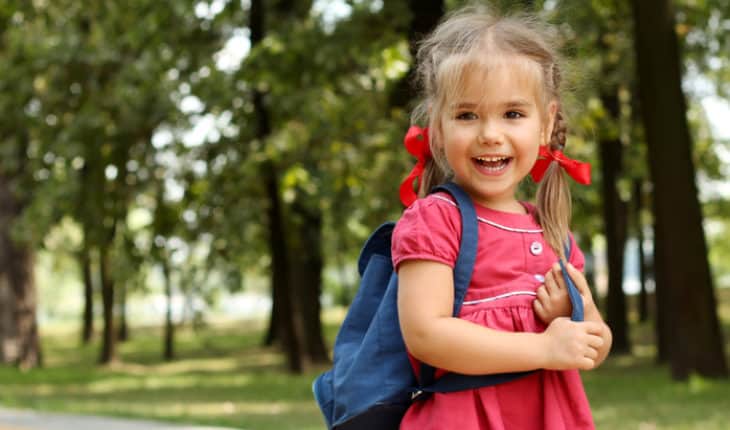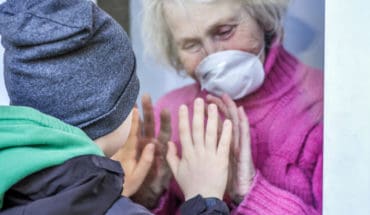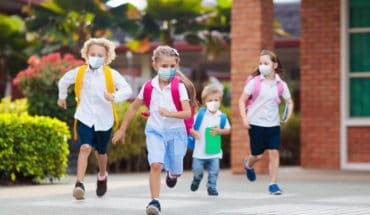GP and mum to two toddlers and a newborn, Dr Laura Lenihan gives you her top tips on how to keep your kids as healthy and happy as possible when they do return to nursery or school.
One of the things I have enjoyed most about lockdown, is having that time to reconnect with our family
One of the things I have enjoyed most about lockdown, is having that time to reconnect with our family, really soak it up. Get more creative about play and learning and enjoy simple forms of exercise together such as family walks and bike rides. But, it hasn’t been easy either. With many parents juggling working from home, childcare and home schooling it’s fair to say that the lockdown has been intense at times for families with babies and young children.
I for one, am breathing a sigh of relief at the thought that childcare and educational settings might be opening their doors again soon. A little bit of structure is well needed. However, with the schools opening there is also an element of trepidation and what effect socialising with others might have on our children health. It’s been a pleasure not having to deal with temperatures or runny noses over the past couple of weeks. While coronavirus might be top of the list of worries, back to school time will also see a resurgence of other common conditions and infectious diseases such as colds, tummy bugs and chickenpox.
1. Hands up for hygiene: especially now in our new normal, hygiene and especially hand washing is going to be hugely important for children going forward. Continuing to hammer home the hand washing message to your child will be vital! Schools can be a common breeding ground for germs and bugs and washing your hands is one of the easiest ways to protect against illnesses such as food poisoning and flu. Make it fun by getting them to sing “Happy Birthday” twice (around 20 seconds) whilst rubbing their hands under running water with a mild soap. It’s instinctive for young children to be curious about touch, but try to explain gently without scaring them, that they need to try not to touch their own or their classmates faces – and to wash their hands regularly throughout the day and when they get home. We have been teaching our little girls about germs, and how they spread and you can definitely do this without scaring them. The other thing, is to cough into elbows going forward, you can even make a game out of it.
2. Spot on: there’s no doubt that there will be a rise in infectious diseases such as chickenpox when school’s return. Chickenpox is a common, but extremely contagious airborne virus which spreads through the air by coughing or sneezing or by touching an infected person. Chickenpox should be easy to “spot”! Look out for small, roundish red patches which develop into blisters. The rash usually starts from the torso and spreads. The risk of infection lasts until all the blisters have scabbed over. In addition to the obvious blisters, typical symptoms are fever, headache and pain in the limbs and very severe itching. Thankfully chickenpox is easy to treat. Try PoxClin CoolMousse – different to other chickenpox treatments it comes as a mousse allowing it to be applied easily and hygienically to a large surface area. It also promotes the skin’s natural healing process and reduces the risk of skin infection and scarring. If you child does have chickenpox, you’ll probably be advised to keep them off school or nursery. Usually it takes seven to 10 days until all of the blisters have crusted over and they’re no longer contagious. So, you might be back to square one again with ‘quarantine’, but you’re a pro now – you’ve got this!
3. School fuel: making sure your child eats balanced, healthy meals and snacks will help keep their immunity in check. The occasional treat is fine, but try to keep sugary snacks or processed foods to a minimum. Experiment with brightly coloured snacks such as slices of peppers, oranges, avocados, strawberries, blueberries, carrots and apples. Kids love the colours and fruit and veg is a great source of vitamins A & C. Protein also plays a role in the immune system, so try toincorporate sources such as chicken, fish, eggs, beans and chickpeas. As the saying goes, breakfast is the most important meal of the day so set them up good with a nice wholesome breakfast before school. Also, when school’s reopen, pack a water bottle for your child so they can sip it throughout the day and stay hydrated.
4. Sleep on it: for many families, the lockdown has played havoc with sleep routines. Don’t be hard on yourself if bedtime rules have gone out of the window recently, but do try to get your kids back into a good routine so they’re well rested and ready for the day ahead. There’s no hard and fast rules but as a general guide, toddlers need around 12 hours of sleep a night; children aged three to six – 10-12 hours; Sticking to some bedtime rituals can really help: try following some simple “wind down” techniques before bed each night e.g. a warm bath and then story time with their favourite story or poem.
5. Ask for help: if you need it: it’s natural for parents of young children to feel anxious about their child’s health during these difficult times. We’re all adapting to a new normal. But remember, medicine and sickness doesn’t care about coronavirus, so if you have any worries please be sure to contact your GP. It’s really important that we don’t forget that. While social distancing is changing the way that we “see” patients, we are still there when you need us. If you have any concerns at all about your child’s health, check with a pharmacist or book an online or ‘phone appointment with your GP.
- My C-Section story & advice - 9th October 2020
- Back to school: Keeping your kids healthy - 18th May 2020







